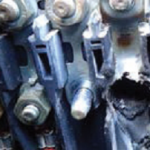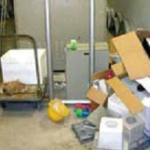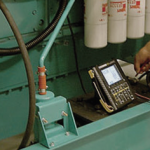| Defects |
Probable causes for the defect |
Design for Maintainability (DfM) Guidelines |
Generator: noise, vibe & overheating
 Burnt fuse |
- Insufficient ventilation by radiator – water level is low or inadequate opening in the generator room.
- Overloading or unbalanced load.
- No acoustical control is provided.
- Vibration isolator is ineffective due to improper mounting.
- Vee belt is loose or too tight.
|
Design
- Design mains failure standby power generation system as per code requirements.
- Provide sufficient headroom (>2600mm) in generator rooms for maintenance tasks — i.e. sufficient height to
enable any portion of the generating set or equipment to be raised freely for dismantling — as per SS 535:2007. (See also BS 7698-7:1996, ISO 8528-7:1994, NFPA 110:2016).
- Comply with the general guidelines for earthing of generator sets and substations (BS 7430: 2011+A1:2015, SS 551:2009).
- Adhere to the recommendations for daily diesel service tank package and tank storage (i.e. safety and suitability of design, emergency provisions, and minimisation of vapour hazard) as per SS 532:2016. (See also BS 5908-1:2012).
Construction
- Conform to requirements for the construction, installation and testing of generator systems for buildings.
- Provide sufficient access and clear passage for construction and maintenance.
- Allotted spaces must be of sufficient strength or suitably strutted to support the loads (SS 535:2007, BS 7698-
7:1996, ISO 8528- 7:1994, NFPA 110:2016).
- Install indoor fuel tank with a level indicator that can be easily accessed for observation.
- List and mark electrical wiring and equipment located near/within hazardous zones (i.e. day tank) (as defined by NFPA 70B [7] or IEC 60079) for installation in an appropriate manner (SS 532:2016, BS 5908-1:2012).
Maintenance
- Practice proper housekeeping and avoid stacking and storing of combustible materials in the generator house.
- Maintain records of preventive maintenance activities in a secure manner.
- Conduct general inspections daily and check on fuel, lubrication and cooling systems.
- Perform a monthly running of the generator on no load for half an hour.
- Check battery charger, starting batteries and drive belt tension.
- Adhere to the requirements for operation and maintenance of standby generator systems for buildings.
- Once a year, run load test on the generator and check to ensure that emergency supply can support all essential emergency services (SS 535:2007, BS 7698-7:1996, ISO 8528-7:1994, NFPA 110:2016).
|
| Dirty, leaky generator body |
- Filters are clogged and dirty.
- Poor servicing – rusts should be removed and after that parts should be painted or lubricated.
|
| Damaged generator insulation |
- Damaged during transportation and not checked before installation.
- Frequent / extended operation at stand by rating.
- Overheating is not detected through testing for a long time.
|
Upkeeping and safety issues of generator house
 Combustible materials stored in generator house |
- Unsafe practices and no housekeeping rules for generator house.
|
No / delayed / less power supply
 Charging batteries of generator  Failed connecting rod of diesel generator (Photo credit: Juarez et al., 2016) |
- Power source is not reliable or under capacity.
- Wrong circuit design or wiring – it is unable to activate the generator or battery when the normal power supply is cut. Such control should be tested and marking on DBs are recommended to avoid ambiguity.
- Generator fails to start automatically due to insufficient air intake for combustion, excessive corrosion or faulty limit switch.
- Battery goes flat – over discharged or not charged properly, tampered, electrolyte condition not satisfactory.
- Leakage in battery due to excessive rusting, poor cleaning or painting.
- Poor contact at any junction or battery terminals – careless maintenance or rusting esp. in damp and dirty storage place.
- Voltage-dip during transfer of power to alternate source if the transfer mechanism is faulty. UPS should be used for critical circuits.
|
References
[1]
Normative References/Standards Referred to for Air Handling Unit and Fan Coil Unit



